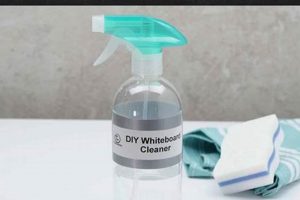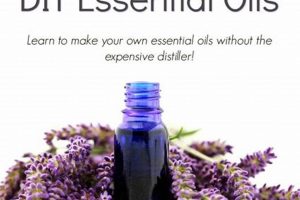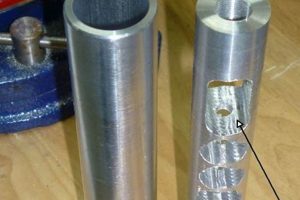Achieving professional-looking results on vehicle bodywork at home requires diligent preparation, careful execution, and a commitment to quality. Success in this endeavor hinges on acquiring specific knowledge and implementing effective techniques. These foundational practices significantly improve the outcome of individual repair projects.
Proper execution of vehicle restoration offers cost savings and personalized vehicle maintenance. Historically, auto body repair was confined to specialized shops; however, increased availability of tools, materials, and instructional resources has empowered enthusiasts to undertake smaller repairs. This allows for greater control over the repair process and promotes vehicle longevity.
The following sections will explore essential aspects of performing auto body repairs, including surface preparation, dent removal, filler application, painting, and safety considerations, all crucial for achieving satisfactory and durable results in your vehicle restoration projects.
Essential Guidance for At-Home Auto Body Restoration
Achieving satisfactory results in auto body repair necessitates adherence to specific methodologies. The following provides insights aimed at improving the quality and durability of DIY auto body work.
Tip 1: Prioritize Surface Preparation: Proper surface preparation is critical for adhesion and preventing future corrosion. This involves thorough cleaning with degreasers, removal of rust with abrasives or chemical treatments, and feathering the edges of existing paint to create a smooth transition.
Tip 2: Master Dent Removal Techniques: Small dents may be addressed with specialized tools such as dent pullers or heat guns combined with cold treatments. Larger dents might require the use of body hammers and dollies to reshape the metal gradually and carefully.
Tip 3: Apply Body Filler Sparingly and Accurately: Body filler should be used to smooth imperfections, not to rebuild large areas. Apply in thin layers, allowing each layer to cure before applying the next. Proper mixing ratios and curing times are essential for structural integrity.
Tip 4: Sanding with Precision is Key: Sanding is essential for a smooth, professional finish. Progress through increasingly finer grits of sandpaper to eliminate scratches and create a uniform surface for priming and painting. Wet sanding techniques can minimize dust and improve the final finish.
Tip 5: Invest in Quality Primers and Paints: Selecting the correct primer for the substrate and using high-quality automotive paints are crucial for durability and color matching. Consider using a two-part epoxy primer for enhanced corrosion resistance.
Tip 6: Follow Proper Painting Procedures: Apply multiple thin coats of paint rather than one thick coat to avoid runs and sags. Maintain a consistent distance and angle with the spray gun for even coverage. Proper ventilation and personal protective equipment are essential during painting.
Tip 7: Understand Clear Coat Application: Clear coat protects the base coat and provides a glossy finish. Apply clear coat in multiple thin coats, allowing sufficient flash time between coats. Sanding and buffing the clear coat after it has fully cured can further enhance the final appearance.
These directives emphasize the importance of meticulous execution, quality materials, and adherence to established practices. By implementing these strategies, individuals can enhance the outcome and durability of their automotive restoration efforts.
The subsequent sections will delve into specific tools and materials to create cost-effective solutions for auto body repair projects.
1. Surface Preparation Imperative
The efficacy of any at-home automotive body repair project is inextricably linked to the quality of surface preparation. This step serves as the foundation upon which all subsequent repair processes are built. Inadequate surface preparation, such as failing to remove rust or contaminants, directly compromises the adhesion of fillers, primers, and paints. This, in turn, leads to premature failures, including peeling paint, blistering, and accelerated corrosion.
Consider, for instance, a scenario where a vehicle owner attempts to repair a rusted quarter panel without adequately removing the rust. The body filler, despite being properly applied, will eventually separate from the metal as the rust continues to expand beneath it. Similarly, applying primer over a contaminated surface, such as residual wax or grease, inhibits proper bonding, resulting in the primer and subsequent paint layers flaking off over time. Therefore, meticulous cleaning, sanding, and degreasing are not merely recommended; they are critical prerequisites for achieving a durable and lasting repair.
In summation, surface preparation is not simply a preliminary task but a governing factor that dictates the longevity and visual appeal of the final repair. The effort invested in thorough preparation will directly translate into a more robust and aesthetically pleasing outcome. Failure to recognize and execute this imperative will invariably result in compromised results and potential rework, underscoring its central role in effective automotive body restoration.
2. Precise Dent Removal
Achieving professional-quality auto body repairs hinges significantly on the precision with which dents are removed. Suboptimal dent removal techniques can lead to visible imperfections, compromised structural integrity, and reduced vehicle resale value. The following explores critical facets of precise dent removal as they relate to effective at-home auto body repair strategies.
- Assessment of Damage Type
Different dent types, such as sharp dents, broad dents, or crease dents, necessitate varying removal techniques. Sharp dents often require specialized tools like dent pullers or slide hammers, while broad dents may respond well to heat application and gentle reshaping. Accurate assessment of the dent type is crucial in selecting the appropriate repair method and avoiding further damage. Application of the wrong technique can exacerbate the problem, increasing repair complexity and cost.
- Tool Selection and Proficiency
A range of tools are available for dent removal, each with specific applications and skill requirements. These include body hammers, dollies, dent pullers, stud welders, and heat guns. Selecting the right tool for the task is essential, but proficiency in its use is equally critical. Inexperienced users can easily cause more harm than good, creating stretching or weakening the metal panel. Proper training and practice are crucial before attempting dent removal on a vehicle.
- Gradual and Controlled Reshaping
Effec
tive dent removal involves a gradual and controlled reshaping of the metal. Avoid aggressive hammering or pulling, which can overstretch the metal and create a “crowned” appearance. Instead, employ a series of small, incremental adjustments to slowly work the metal back into its original shape. This approach minimizes the risk of damage and allows for greater precision in achieving a smooth, even surface. Patience and a methodical approach are key to successful dent removal. - Minimizing Filler Use
While body filler is often used to smooth minor imperfections after dent removal, the goal should be to minimize its use. Excessive filler can mask underlying problems and compromise the structural integrity of the repair. Precise dent removal reduces the need for filler, resulting in a stronger, more durable, and aesthetically pleasing repair. Striving for near-perfect metalwork before applying filler is a hallmark of professional-quality auto body repair.
These facets highlight the crucial role of skill and knowledge in effective dent removal. Mastery of these techniques directly contributes to achieving durable, aesthetically pleasing, and structurally sound auto body repairs. Ignoring these principles will likely result in repairs that are visually unsatisfactory and potentially compromise the vehicle’s value and safety.
3. Filler Application Method
The method of applying body filler is a critical determinant in the success or failure of do-it-yourself auto body repairs. Erroneous filler application leads to a spectrum of problems, ranging from cosmetic imperfections to structural weaknesses. Consequently, mastering the correct application techniques is essential. Body filler serves to smooth surface irregularities following dent repair or rust remediation, but its function is limited. It is not intended to replace missing metal or to correct gross distortions. Incorrect usage can cause cracking, shrinking, or detachment over time, necessitating rework and potentially causing further damage. This includes improper mixing ratios, application to unprepared surfaces, and excessive application thickness.
A foundational example underscores this principle. A common mistake is applying filler in a single, thick layer. This prevents proper curing throughout the material’s volume, trapping solvents and leading to shrinkage and cracking as the filler ages. Conversely, applying multiple thin layers, allowing each to cure fully before adding the next, promotes complete curing and minimizes these problems. Sanding between coats further improves adhesion and creates a smoother final surface. Furthermore, surface preparation is not merely about cleanliness; it involves creating a mechanical bond through abrasion. Feathering the edges of the repair area allows the filler to blend seamlessly with the surrounding paint, preventing visible lines. Selection of the appropriate filler type is another important consideration, as different fillers are formulated for specific applications and environmental conditions. Using the wrong filler can compromise the repair’s durability.
In summary, the filler application method is inextricably linked to the durability and aesthetic quality of auto body repairs. Adherence to established best practices, including proper mixing, surface preparation, layering, and sanding, is paramount. Failure to do so risks creating repairs that are not only visually unappealing but also structurally unsound, underscoring the practical significance of mastering these techniques for anyone undertaking auto body work at home. Emphasis on proper method during filler application increases repair life and appearance.
4. Quality Product Selection
The effectiveness of any do-it-yourself automotive body repair is significantly determined by the quality of materials used. Employing inferior products undermines even the most skilled techniques. The selection of high-grade fillers, primers, paints, and clear coats is not merely a matter of preference but a fundamental requirement for achieving durable and visually appealing results. Compromising on product quality introduces a cascade of potential issues, including poor adhesion, premature failure, color mismatching, and diminished resistance to environmental factors. Proper preparation, skillful application, and meticulous attention to detail will be negated by substandard materials, resulting in a compromised repair that fails to meet expected standards.
Consider, for example, the use of low-quality body filler. Such products often exhibit poor mixing characteristics, leading to inconsistent curing and increased susceptibility to cracking and shrinkage. This necessitates repetitive repairs and undermines the structural integrity of the restored area. Similarly, inexpensive primers may lack sufficient corrosion resistance, accelerating the deterioration of the underlying metal and compromising the paint finish. In contrast, the utilization of high-quality two-part epoxy primers provides enhanced protection against rust and promotes superior adhesion of subsequent layers. Premium automotive paints offer improved color retention, UV resistance, and scratch resistance, thereby extending the lifespan and maintaining the aesthetic appeal of the repaired area. Choosing quality clear coats similarly provides enhanced protection from the elements.
In conclusion, recognizing the critical link between product quality and repair longevity is essential for successful do-it-yourself auto body work. Investing in quality materials represents a commitment to achieving a superior result and minimizing the likelihood of future problems. While cost considerations are inevitable, prioritizing quality over cost in material selection represents a strategic investment in the long-term durability and appearance of the repaired vehicle. The integration of quality product selection into the auto body repair workflow increases the likelihood of sound repairs.
5. Safety First Always
The principle of “Safety First Always” is inextricably linked to the success and ethical execution of do-it-yourself (DIY) auto body repair. It transcends a mere recommendation, functioning as a foundational prerequisite. Neglecting safety protocols during auto body repair activities can lead to immediate and long-term health consequences, ranging from chemical exposure and physical injuries to potential fire hazards. Consequently, the implementation of stringent safety measures is not merely advisable but critically essential for safeguarding the well-being of the individual and preventing potential property damage.
Auto body repair involves inherent risks, including exposure to hazardous chemicals found in paints, solvents, and fillers. Inhalation of these substances can cause respiratory irritation, neurological damage, and long-term health complications. Similarly, the use of power tools, such as grinders and sanders, carries the risk of eye injuries, lacerations, and musculoskeletal strain. Welding operations present additional hazards, including burns, electrical shock, and exposure to harmful fumes. A comprehensive safety protocol necessitates the use of personal protective equipment (PPE), including respirators, safety glasses, glo
ves, and appropriate clothing. Adequate ventilation is also essential to minimize exposure to airborne contaminants. Fire prevention measures, such as keeping flammable materials away from heat sources and having fire extinguishers readily available, are paramount. Ignoring these safety precautions elevates the risk of accidents and jeopardizes the health and safety of all involved.
In summary, “Safety First Always” is not a peripheral consideration but an integral component of successful DIY auto body repair. It demands a proactive approach, encompassing hazard identification, risk mitigation, and the consistent implementation of safety protocols. Failure to prioritize safety not only increases the likelihood of accidents and injuries but also undermines the ethical responsibility of ensuring a safe working environment. The effective integration of safety practices into every aspect of auto body repair is thus indispensable for safeguarding personal well-being and achieving sustainable, high-quality results. A commitment to safety ensures individual wellbeing and also minimizes potential property damage.
Frequently Asked Questions
This section addresses common inquiries regarding achieving professional results in at-home auto body restoration projects. The aim is to provide clarification on essential techniques, material selection, and safety procedures.
Question 1: Is prior experience necessary to undertake auto body repairs?
While prior experience is beneficial, it is not strictly necessary. However, a willingness to learn and meticulous attention to detail are essential. Starting with smaller, less complex projects and gradually progressing to more challenging repairs is recommended.
Question 2: What are the most critical tools required for basic auto body repair?
Essential tools include a body hammer and dolly set for dent removal, various grades of sandpaper for surface preparation, body filler and application tools, primer, automotive paint, clear coat, a spray gun, and appropriate safety gear such as a respirator and eye protection.
Question 3: How can one ensure an accurate paint color match for a vehicle repair?
The most reliable method is to obtain the vehicle’s paint code, typically located on a sticker within the door jamb or engine compartment. This code allows paint suppliers to precisely mix a matching color. Alternatively, a paint sample can be scanned and matched using specialized equipment.
Question 4: What are the key considerations for achieving a smooth, professional paint finish?
Proper surface preparation, including thorough sanding and cleaning, is paramount. Multiple thin coats of paint applied with a consistent technique are preferable to a single thick coat. Maintaining the correct spray gun distance and angle is also crucial.
Question 5: How can rust be effectively removed and prevented from recurring?
Rust removal typically involves mechanical abrasion using tools such as wire brushes, grinders, or sandpaper. Chemical rust removers can also be effective. Following rust removal, applying a rust-inhibiting primer and ensuring proper paint coverage are essential to prevent recurrence.
Question 6: What safety precautions should be taken when performing auto body repairs?
Adequate ventilation is essential to avoid inhaling harmful fumes. A respirator should be worn when sanding, painting, or working with chemicals. Safety glasses should be worn to protect the eyes from debris. Gloves should be worn to prevent skin contact with solvents and other hazardous materials.
Achieving high-quality results in DIY auto body repair requires a combination of knowledge, skill, and diligence. Adhering to best practices and prioritizing safety are fundamental for success.
The next section will explore common mistakes to avoid during auto body repair projects to enhance outcomes.
Achieving Professional Results in DIY Auto Body Repair
The preceding discussion has illuminated the best tips for DIY auto body repair, emphasizing the crucial roles of meticulous surface preparation, precise dent removal, controlled filler application, judicious material selection, and unwavering adherence to safety protocols. Mastery of these elements is essential for producing durable, aesthetically pleasing, and structurally sound repairs at home. Neglecting any of these areas can compromise the integrity and appearance of the finished product, potentially leading to costly rework or diminished vehicle value.
The consistent implementation of these best practices represents a pathway to achieving professional-quality results in DIY auto body repair. Continuous learning, attention to detail, and a commitment to safety are indispensable. By integrating these principles, individuals can enhance their skill sets, improve the quality of their work, and ultimately contribute to the preservation and enhancement of their vehicles. Further exploration of advanced techniques and emerging technologies in auto body repair will undoubtedly continue to refine and improve the capabilities of DIY enthusiasts.







